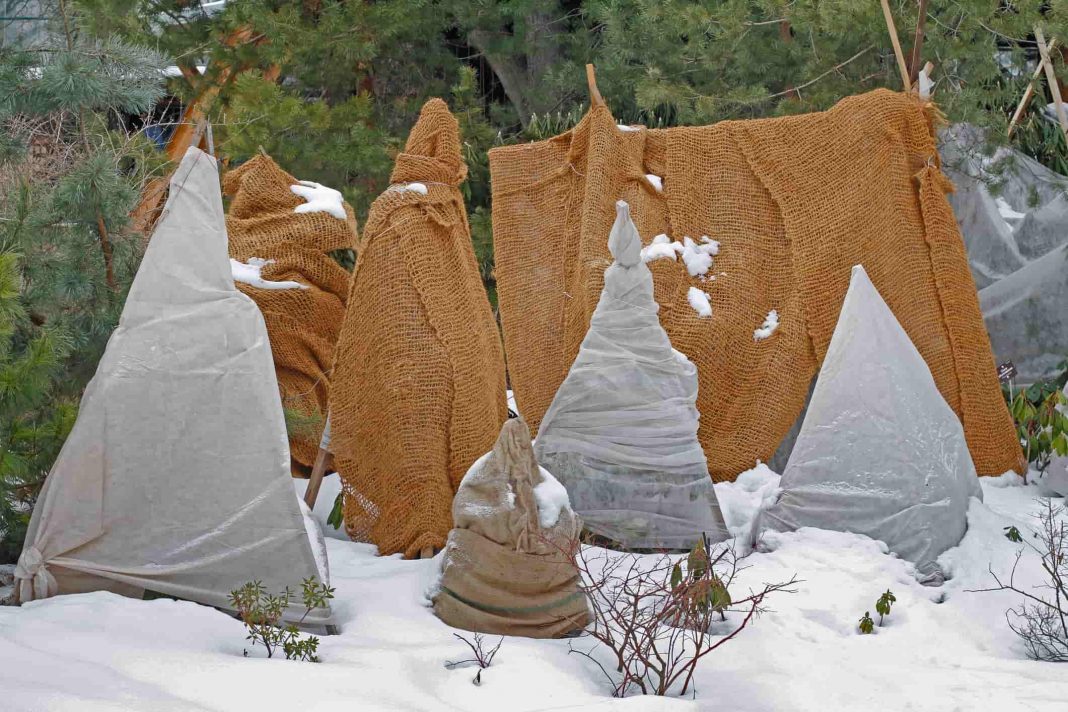December should usher in the beginning of our coldest time of the year and we should see the end of it by the first week or two of March. Sometimes we are blessed with mild winters, like last year. NOAA long range climate prediction for us this winter shows an above normal chance of a milder drier winter again.
At the time of this writing, Accuweather is showing above normal temperatures into the middle of December. During mild winters we can get lucky and get many plants to survive that would normally freeze without protection. Plants such as begonias, vinca, impatiens, alyssum, petunias, tropical hibiscus, and crotons are some plants that can make it through mild winters with little or no protection. Keep in mind that plants close to the south side of your house will stay much warmer because of radiant heat and the absence of the cold north wind.
Follow these steps to help your plants survive freezing temperatures.
WATER:
Before an imminent freeze, make sure that all plants are well watered. Usually cold weather here is accompanied by very dry wind. Cold dry wind can be devastating to dry plants, even more so than hot weather during the summer. Move potted tender plants indoors, including tropical hibiscus, plumeria, young or tropical fruit trees and bromeliads.
MULCH:
Give your plants a “blanket” of mulch. Together with moist soil, this helps protect their roots.
This is adequate protection for many shrubs that can withstand freezing temperatures, including abelia, azalea, boxwood, eleagnus, hawthorn, holly, ligustrum, loropetalum, mahonia, nandina, roses, wax myrtle and yaupon.
Duranta, hamelia, angel’s trumpet and root-hardy hibiscus may lose all or some of their tops in a hard freeze. But water and mulch, and they will likely return from their roots in spring. Covering them is optional.
Be sure to protect the grafts of citrus trees by mulching up above the graft. This will leave the grafted “citrus making wood” intact. We have had several people tell us that after a very hard freeze that their citrus trees grow like crazy but never put on fruit again. This has happened because the grafted citrus wood has died and left only the root stock to grow. The root stock will never produce anything but a lush quick growing very thorny tree with nothing to show for it.
PROVIDE COVER:
Freeze cloth is the favored product for covering plants. It is a lightly woven material that can provide you with 15 degrees more heat when installed properly without putting so much pressure to cause damage to your tender plants. DO NOT PUT PLASTIC DIRECTLY ONTO PLANTS. Many shrubs, trees and winter annuals tolerate cold, but may have their blooms freeze. Cover flowering azaleas, camellias and fruit trees with row cover, sheets or blankets. Anchor the covers with bricks or stones. Use nursery pots or cardboard boxes to create mini greenhouses for smaller plants. Milk jugs make great little greenhouses. Tender palms like queens can be protected by wrapping with small Christmas lights and then wrap with frost cloth. Be sure and protect the new growth area coming out of the middle as well. Many times when that freezes your palm is history. Tender trees like avocados can be protected by covering and using pipe insulation around the trunk if it does not have any bark on it. Winter plants like pansies, dianthus, ornamental cabbage and snapdragons are very cold tolerant that I have seen take temperatures down into the teens without any damage. However, snapdragon blooms tolerate slight dips but show damage unless covered when it drops into the 20s. Plants like petunias, alyssum, calendula, and lobelia take our normal winters ok but may suffer minor damage when temps go and stay too long into the twenties. When hard freezes are predicted it would be a good idea to throw some frost cloth on these to limit damage. Cyclamen plants will tolerate more cold than the flowers. If a freeze is predicted it would be wise to protect the flowering cyclamen to preserve those beautiful flowers. When freezing rain is forecast, cover plants with sheets and blankets, then cover these with a heavier plastic and secure with bricks and stones.
AFTER FREEZE:
Do not wash frost/ice off plants the morning after a freeze. This raises the temperature too quickly and usually damages the plant’s cell tissues. Be sure to remove frost protection. Wait until the ice thaws, then assess plant damage. Hire a certified arborist to remove large or heavy broken branches from trees. If one-third or half of the major limbs are broken, or the trunk is split, decide whether first aid is practical or whether it is best to remove the tree. Provide support for young trees bent with the weight of ice. After a freeze, remove soggy, damaged parts on soft-stemmed plants such as impatiens and crinums. Do not prune woody plants such as garden hibiscus and hamellia. Leave the freeze-damaged wood to protect live wood farther down the branch. Prune to green, live wood in the spring, after the threat of freezes has passed.
In the spring, fertilize to encourage new growth and rejuvenate damaged plants.
Things to do in December
*December is a great time to relocate any shrubs or trees.
*Remember that in absence of rain, watering still needs to be done to help plants rebuild damaged roots from the summer heat and drought.
*Take a break from yard work and enjoy the holidays with loved ones.
For great gardening products and information, come by the Growers Outlet and visit with any member of our team to get the help you need or go to our website at WWW.growersoutletinwillis.com. We have the products and knowledge to help you have the prettiest yard on the block.



















